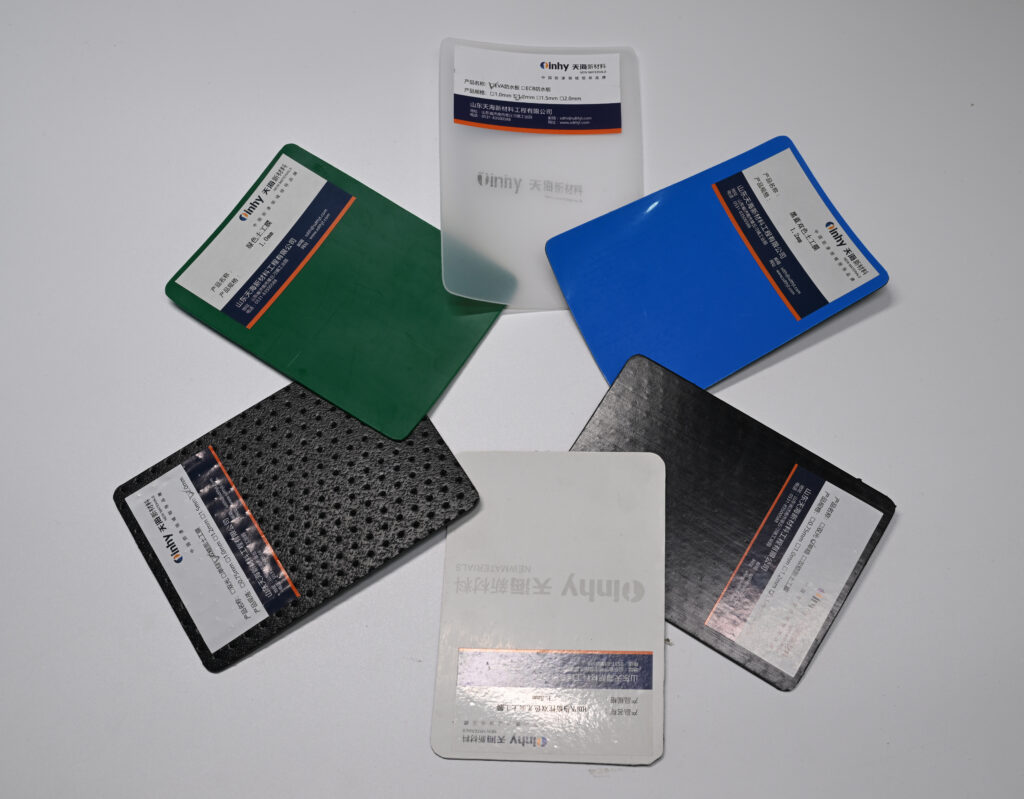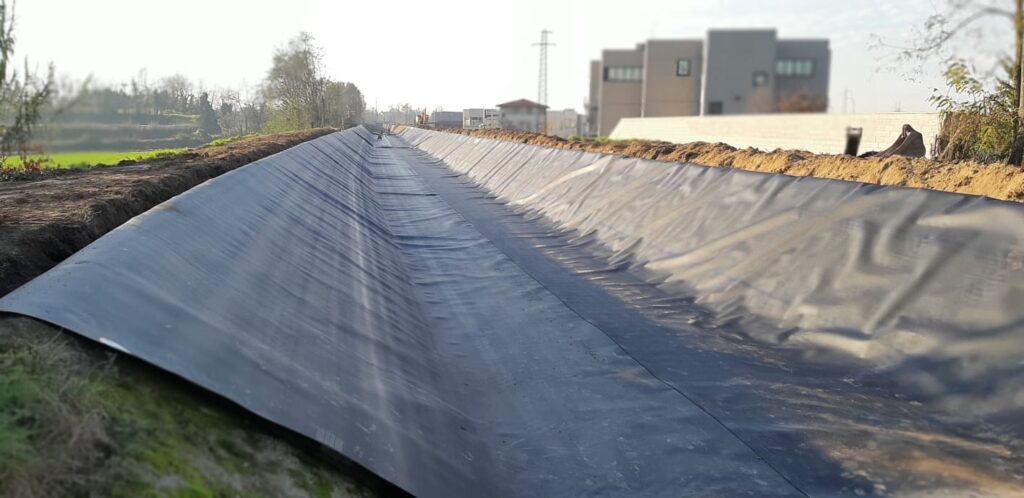What is geomembrane?
A geomembrane is a type of synthetic membrane with a very low permeability, used primarily as a barrier to prevent the movement of fluids, gases, or contaminants. Geomembranes are commonly made from polymeric materials such as high-density polyethylene (HDPE), polyvinyl chloride (PVC), low-density polyethylene (LDPE), and ethylene propylene diene monomer (EPDM), among others.
Key Characteristics of Geomembranes:
Low Permeability: Geomembranes are designed to prevent liquids or gases from passing through, making them ideal for containment purposes.
Durability: They are resistant to chemical attack, UV radiation, and environmental factors like temperature changes and pressure, which makes them last long in harsh conditions.
Flexibility: Depending on the type of polymer used, geomembranes can be flexible and easily conform to different surfaces, including uneven or rough terrains.
Applications of Geomembranes:
Environmental Protection and Containment:
Landfill liners and covers: Geomembranes are used to line the base of landfills and cover them after closure, preventing leachates from contaminating groundwater.
Mining operations: Used as barriers in heap leach pads and tailings dams to contain mining byproducts.
Water reservoirs and ponds: Prevent water loss in man-made reservoirs, irrigation ponds, and aquaculture.
Waterproofing:
Tunnels and foundations: Applied in construction to provide waterproofing solutions in tunnels, basements, and other structures where groundwater protection is required.
Dams and canals: Used in lining the sides and bases of dams and canals to prevent seepage, thus conserving water and maintaining the structural integrity of the dam.
Wastewater Treatment:
Geomembranes are employed in the containment of wastewater in treatment plants, helping to manage and control seepage from treatment lagoons or ponds.
Secondary Containment:
In industrial settings, geomembranes are often used as secondary containment systems for fuel storage, chemical containment, or other hazardous substances to prevent environmental contamination.
Types of Geomembrane Materials:
HDPE (High-Density Polyethylene): Known for its chemical resistance, UV protection, and durability. It is widely used in harsh environments, such as landfills and mining operations.
PVC (Polyvinyl Chloride): More flexible than HDPE, often used in applications that require the geomembrane to conform to complex shapes, such as ponds or small containment areas.
EPDM (Ethylene Propylene Diene Monomer): Highly flexible and resistant to weathering, used in applications like roofing membranes, ponds, and water reservoirs.
LDPE (Low-Density Polyethylene): More flexible than HDPE but with slightly lower chemical and UV resistance. It is used in smaller-scale containment projects.
In summary, geomembranes play a crucial role in environmental protection, water conservation, and construction by providing durable, impermeable barriers that contain or direct liquids and gases.

The significance of geomembrane to construction projects
Geomembranes are synthetic membranes with very low permeability, primarily used in construction projects to control the movement of fluids and gases. They play a critical role in a variety of construction projects due to their versatility, durability, and resistance to chemicals. Here’s why geomembranes are significant in construction:
1. Environmental Protection
Containment of hazardous materials: Geomembranes are often used as liners in landfills and mining projects to prevent toxic leachates or chemicals from seeping into the ground or nearby water sources.
Water management: They are used in water reservoirs, canals, and ponds to control seepage and water loss, maintaining water availability for irrigation, industrial use, and drinking purposes.
2. Preventing Erosion and Soil Contamination
Geomembranes serve as barriers that help stabilize the soil and prevent erosion in areas susceptible to heavy rainfall or water runoff.
By preventing the infiltration of harmful chemicals into the ground, they help protect soil quality in industrial zones, chemical plants, and agricultural areas.
3. Waste Management
Landfills: Geomembranes line the base and cover of landfills to contain solid and liquid waste, preventing leakage of harmful substances into the surrounding environment.
Wastewater treatment plants: In construction of treatment plants, geomembranes are used in lagoons, ponds, or basins to contain treated and untreated water.
4. Durability and Flexibility
Resistant to degradation: Geomembranes are made of materials like polyethylene (HDPE) or PVC, which are highly resistant to chemicals, UV light, and extreme weather, ensuring their longevity in harsh environments.
Ease of installation: Due to their flexibility, geomembranes can easily conform to complex shapes or contours in the terrain, making them ideal for irregular surfaces like slopes, mining sites, or reservoirs.
5. Cost-Effective Solution
While the initial investment in geomembranes may be significant, they save costs in the long term by reducing maintenance needs, controlling seepage, and minimizing environmental damage that could result in regulatory fines or clean-up expenses.
6. Energy Efficiency
Geomembranes can improve energy efficiency in construction projects, such as using them in the construction of bioenergy plants to ensure proper containment of gases like methane, which can be captured and used as a renewable energy source.
7. Applications in Civil Engineering
Road construction: Geomembranes are often used under roads, highways, and embankments to prevent water infiltration, which can weaken the underlying soil and cause structural damage.
Tunnels and foundations: In tunnel construction and foundation work, geomembranes act as waterproof barriers to prevent water ingress, ensuring structural stability.
Overall, geomembranes provide an essential component for sustainable and safe construction practices, ensuring proper containment, reducing environmental risks, and enhancing the longevity of infrastructure projects.

What is the role of geomembrane?
The role of a geomembrane is to serve as a protective barrier, primarily used to control the movement of fluids and gases within various construction and environmental projects. Its main function is to contain or prevent the seepage of liquids, gases, or contaminants, ensuring that environmental systems, structures, and industrial processes remain safe and effective.
Key Roles of Geomembranes:
1. Containment
Preventing Contamination: Geomembranes are used to line landfills, mining sites, and chemical plants to contain hazardous materials, preventing them from seeping into the soil and groundwater. In landfills, they act as a liner that prevents leachate (liquid from decomposed waste) from contaminating surrounding areas.
Water Retention: In reservoirs, ponds, and canals, geomembranes are employed to contain water, preventing losses through seepage. This is crucial for water conservation in areas where water resources are limited.
2. Environmental Protection
Groundwater Protection: By acting as an impermeable layer, geomembranes prevent toxic substances, pollutants, and chemicals from entering and contaminating groundwater supplies.
Soil Protection: In industrial and agricultural applications, geomembranes act as barriers that prevent harmful chemicals, fertilizers, and pesticides from entering the soil, preserving soil quality and preventing land degradation.
3. Waterproofing
Infrastructure Protection: Geomembranes are used in tunnels, foundations, basements, and roofs to provide waterproofing. This helps protect these structures from water infiltration, which could weaken the foundation or cause structural damage.
Dams and Levees: Geomembranes are used as linings for dams, canals, and levees to prevent water from seeping through earthen structures, ensuring their long-term stability and effectiveness.
4. Waste Management
Landfill Liners and Caps: In solid waste management, geomembranes play a dual role. They line the base of landfills to prevent contaminants from seeping into the environment and are also used to cover landfills after they are filled, containing gases and reducing odors.
Wastewater Treatment Plants: Geomembranes are commonly used to line lagoons, ponds, and other containment structures in wastewater treatment plants, ensuring that untreated or partially treated wastewater does not leak into the surrounding environment.
5. Erosion and Sediment Control
Slope Stabilization: Geomembranes are used in conjunction with other geosynthetics to stabilize slopes and embankments. They act as barriers to control erosion by preventing water infiltration into the soil, thereby reducing the risk of landslides or soil erosion.
Coastal Protection: In marine construction, geomembranes are used as part of breakwaters, seawalls, or underwater containment systems to prevent the erosion of coastal soils and control sedimentation.
6. Gas Control and Collection
Gas Barriers in Landfills: Geomembranes are used to trap and collect gases, such as methane, generated by decomposing waste in landfills. The collected gases can then be used for energy generation or safely vented to prevent explosions.
Radon and Vapor Barriers: In buildings, geomembranes can act as vapor barriers to prevent the infiltration of harmful gases like radon, ensuring a safer indoor environment.
7. Structural Reinforcement
Roads and Embankments: In road construction and embankment stabilization, geomembranes are used in conjunction with geotextiles to reinforce the ground, improve soil stability, and enhance the load-bearing capacity of the surface.
Geotechnical Engineering: In projects like retaining walls, dam construction, or mining, geomembranes provide support by serving as a separation layer between different materials or as a base liner to prevent water migration.
8. Chemical Resistance and Durability
Chemical Containment: Geomembranes are highly resistant to a wide range of chemicals, including acids, oils, and solvents. This makes them ideal for lining chemical storage facilities, fuel containment areas, and other industrial zones where exposure to hazardous substances is common.
Long-Term Performance: Geomembranes are designed to withstand UV radiation, extreme temperatures, and mechanical stress, ensuring their performance over long periods even in harsh environments.
Summary of Roles:
Containment: Preventing seepage of liquids, gases, and contaminants.
Environmental Protection: Safeguarding soil and groundwater from pollutants.
Waterproofing: Ensuring the integrity of infrastructure by preventing water infiltration.
Waste Management: Lining landfills, wastewater ponds, and other waste containment systems.
Erosion Control: Preventing soil erosion in slopes, embankments, and coastal areas.
Gas Control: Collecting landfill gases and preventing harmful vapor intrusion.
Reinforcement: Stabilizing roads, embankments, and geotechnical structures.
Chemical Resistance: Providing durable protection in industrial and hazardous environments.
Geomembranes are crucial for ensuring the integrity and sustainability of construction, environmental protection, and industrial projects.
近期文章
Author
-

Founded in 2002, Tinhy's team focuses on the manufacturing, marketing, installation, application and research and development of geosynthetic materials.
View all posts

